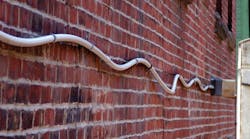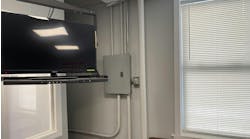How well do you know the Code? Think you can spot violations the original installer either ignored or couldn’t identify? Here’s your chance to moonlight as an electrical inspector and second-guess someone else’s work from the safety of your living room or office. Can you identify the Code violation(s) in this photo? Note: Submitted comments must include specific references from the 2011 NEC.
Hint: This is not a sine wave.
‘Tell Them What They’ve Won...’
Using the 2011 NEC, correctly identify the Code violation(s) in this month’s photo — in 200 words or less — and you could win something to put in your toolbox. E-mail your response, including your name and mailing address, to [email protected], and Russ will select three winners (excluding manufacturers and prior winners) at random from the correct submissions. Note that submissions without an address will not be eligible to win. Winners will receive a fluorescent lighting tester from Milwaukee Tool, valued at $199. The product allows complete lamp, ballast, and pin testing, before or after install, without dismantling fixtures.
(*Please allow six to eight weeks for delivery of tools.)]
JANUARY WINNERS
Our winners this month include: Matt Atkinson, a journeyman electrician with West Valley City Co. in Kamas, Utah; Daniel Shkroba, an electrical technician with I/N Tek & I/N Kote in New Carlisle, Ind.; and George Calvert, an electrician with Brewster Electrical Services in Glendale Heights, Ill. All three of these guys knew that storing water bottles in front of electrical panels is a Code violation.
Section 110.26(B) clearly states that working space in front of this panel cannot be used for storage. In addition, 110.26(A) establishes some minimum dimensions that must be maintained in order to allow workers to safely inspect service and maintain the electrical equipment. The minimum depth needed as described in Table 110.26(A)(1) is 3 ft, 3.5 ft, or 4 ft — depending on the conditions.
In this installation, the minimum depth would need to be 3 ft. The minimum width needed would be 30 in. or the width of the equipment if its width is greater than 30 in., according to 110.26(A)(2). Section 110.26(A)(3) requires the work space to be clear and extend from the floor to a height of 6.5 ft or to the equipment’s height if higher than 6.5 ft. Lastly, 240.24(A) requires overcurrent devices to be readily accessible. The water bottles prevent that from happening.






